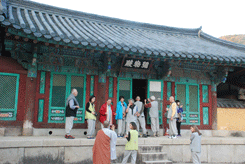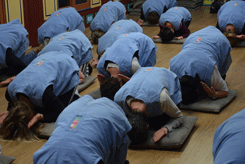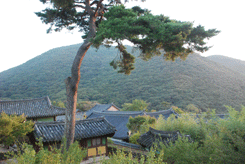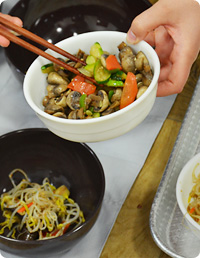Temples
 |
 |
 |
Information
Buddhist philosophy dictates that a cluttered mind is an unhealthy mind. Many of us revolve endlessly around daily obligations, submitting to demanding schedules, so one such option for escape is a temple stay. As city congestion and a hurried sense of belonging are not exactly conducive to a tranquil mind, retreating outside the city for the night is a good option and one sure to leave lasting impressions. Temple stay is an invitation to Korean Temples, a world of tradition and harmony. Korean temples have been the spiritual refugee to Koreans for some 1600 years. Modern life is fast paced and stressful. Living in a hectic world, you are in a constant hurry to go somewhere. Temple stay programs give modern people a break from busy routines, an opportunity to concentrate on stillness and contemplation without all the accouterments you carry throughout the urban lives. The Jogye Order of Korean Buddhism offers foreigners and Koreans a chance to experience the unique lifestyle of monks and nuns from early morning chanting to the evening meals. The program, depend on the temples, includes Buddhist ceremonial service, meditation, Monastic meal - Barugongyang, the tea ceremony, printing and rubbing of Tripitaka Koreana, monk's martial art practice, lotus flower lantern making and temple bell ringing. The program offers visitors to experience traditional culture absorbed by Korean Buddhism and sense of Korean monastic life. You are advised to come with an open, flexible mind to make the most of your experience. Bowing and chanting are also an important part of the Korean Buddhist tradition. Depending on the interests of each individual, you can participate as much or as little in these activities as you feel comfortable. There are selective temples around Korea, steeped in ancient traditions and enveloped in elegant natural environments, and they offer the chance to get away from it all, to look within yourself, and to enjoy a program that you will find eye-opening as you experience a traditional monastic lifestyle.
Please mind the followings when visiting Buddhist temples
Temples are shrines to the Buddha, Bodhisattvas and traditional folk spirits. They are also religious places for followers of the Buddha's teachings. Also the temples are the places where Buddhist monks and nuns live, study and practice. Lay Buddhists also visit temples. Therefore, certain manners are required to show respects to them. Visitors should also strive try to keep pure and calm minds. Innumerable cultural artifacts and treasures have been handed down through the ages and temples are repositories of these, both in exhibition halls and in the surrounding environment. Visitors are asked to observe all regulations and treat everything with care.
Desirable appearance
Dress in the temple should be clean, neat and conservative. One should avoid brightly colored clothes, outlandish clothes, heavy makeup, strong perfume and excessive accessories. One should not wear revealing clothing such as sleeveless tops, mine skirts and shorts. Bare feet are not allowed in the temple.
How to greet others
Putting your hands together (Hapjang) as if in prayer. It is the most simple and meaningful way of greeting Buddhists. When you have your hands together with both palms pressing against each other, you dispel all discursive thoughts and focus your mind into a single point. You can practice such true virtue as respect, consideration, or reconciliation in complete sincerity, and give a polite nod without any word.
Desirable behavior
One should be quiet and gentle within a temple. Please be careful not to speak loudly, shout, run, sing, or play music. Men and women should avoid intimate physical contact. Eating and drinking should be done only in designated areas. Do not walk around eating snacks, drinking beverages or chewing gum. Drinking alcohol and consuming meat and fish is strictly banned. Also smoking is banned in all parts of the temple. Garlic, leek, wild rocambol, Chinese squill and scallion are not recommended for the Buddhist monks. Taking pictures inside the Buddha hall and other temple buildings is not allowed. Do not keep your arms crossed on the chest at any occasions. When using the bathroom, take care to wash your face in a quiet and composed manner. Avoid wasting water since it is a limited resource.
General manners in the Buddha Hall
Do feel free to go into the temple and small shrines. But, please keep the following rules when you enter any hall on the temple compound.
1. The main hall generally has three entrances, the front or center entrance and ones to the left and right. Use the left or right one, the center is reserved for monks.
2. Take your shoes off to enter the halls or shrines.
3. When opening or closing the door, do not make noise. Lightly lifting the door as you move it will reduce the noise.
4. When you enter the hall, bow to the Buddha with palms together. Also bow to the Buddha before you leave the hall.
5. The center of the hall in front of the Buddha is for monks only. Do not sit or stand there.
6. Do not lie down on the floor of the hall or sit on a doorsill.
7. Avoid passing in front of others who are praying or making prostrations. When you have to, pass quietly with palms together.
What to bring
-Overnight visitors should bring their own toiletries and towel, since many temples do not provide these items.
-Wear comfortable and clean clothes.
-Always wear socks within the temple.






